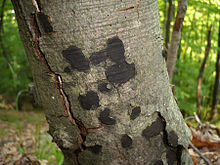Biscogniauxia nummularia
| Biscogniauxia nummularia | |
|---|---|

| |
| Scientific classification | |
| Domain: | Eukaryota |
| Kingdom: | Fungi |
| Division: | Ascomycota |
| Class: | Sordariomycetes |
| Order: | Xylariales |
| Family: | Graphostromataceae |
| Genus: | Biscogniauxia |
| Species: | B. nummularia
|
| Binomial name | |
| Biscogniauxia nummularia | |
| Synonyms | |
| |
Biscogniauxia nummularia is a plant pathogen in the family Graphostromataceae, known as the beech tarcrust.[1] The specific epithet is derived from the Latin "nummus" meaning a coin, referring to the often rounded and coin-like encrustations.
Description
[edit]The fruit body forms a thick and shiny black crust, on beech (Fagus) bark and is found at all times of the year. It is not edible.[1] Young specimens are covered by a light brown outer layer. The spores are black to dark brown.
-
Detail of the tarcrust's structure
-
Beech tarcrust growth
-
Encrustations on beech bark
Distribution
[edit]Biscogniauxia nummularia is a common pathogen specific for Beech trees, and has been recorded throughout Europe and Russia.[2]
Environmental impact
[edit]The decline of European beech (Fagus sylvatica) in Sicily and Calabria (Italy) has been linked to B. nummularia and experiments have suggested that this ascomycete plays a primary pathogenic role under certain environmental conditions.[3] It typically causes strip-cankering and general wood decay.[4]
References
[edit]Notes
[edit]- ^ Jump up to: a b Phillips, Page 376
- ^ B. nummularia : Accessed : 2010-03-19
- ^ Forest Pathology : Accessed : 2010-03-19
- ^ "Biomed Experts : Accessed : 2010-03-19". Archived from the original on 2015-09-23. Retrieved 2010-03-19.
Sources
[edit]- Phillips, Roger (2006). Mushrooms. London : Pan MacMillan. ISBN 0-330-44237-6



